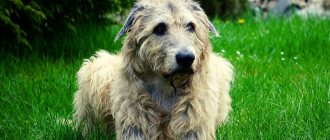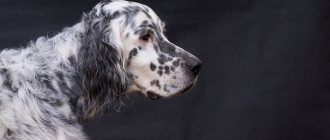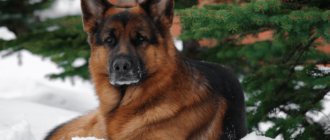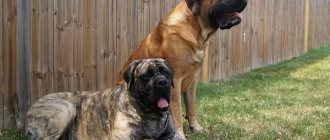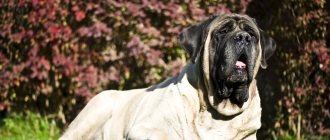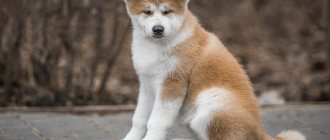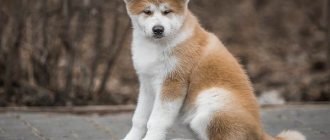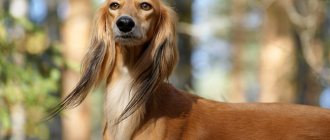Description of the Irish Setter breed
Popularity 213 place among 263 dog breeds
Lifespan:
13-15 years old
Breed group:
Cops
Height:
males: 58-67 cm, females: 55-62 cm
Country of origin:
Ireland
Average price:
20-30 thousand rubles
Weight:
27-32 kg
Latest articles Cat health
Rabies vaccination for cats: choice of vaccine, necessity, schedule 01/22/2022 20 0 0
Selection and adaptation
TOP 20 best cat breeds for families with children 01/22/2022 33 0 0
Who Lives Longest, Neutered or Unneutered Dogs?
Removing reproductive organs does not affect the number of years a dog will live. It's all about the timeliness and quality of the operation. This is a serious hormonal change in the body. Mature, healthy individuals will cope with it with the least losses. The desirable condition is to wait until the animal’s skeleton is fully formed, that is, the age is from one year to 2.5. If the procedure is performed before the first heat/estrus, there is a risk of bone destruction from cancer (osteosarcoma).
For dogs the risk increases:
- Heart diseases (oncological);
- Thyroid diseases;
- Prostate cancer;
- Obesity;
- Oncology of the urinary system.
There are also positive sides to castration. This is the fix:
- Testicular cancer;
- Prostate disease;
- Chances of diabetes.
The advantages of castration of females are considered to be the following:
- Mastitis;
- Inflammation of the uterine cavity (pyometra);
- Oncology of the genitourinary system.
Disadvantages of removing reproductive organs:
- Cancer of the spleen and heart (hemangiosarcoma);
- Hypothyroidism;
- Obesity;
- Urinary incontinence;
- Vaginal problems;
- Infection/oncology of the urinary tract.
For animals of both sexes, the likelihood of orthopedic disorders increases. Negative reactions to vaccination may occur.
Increased exercise (long walks) and training will help fight obesity. Or, following the example of the North American Indians, this breed can be harnessed to a team.
If medical error is excluded, castrated individuals can happily live to the upper limit of average norms, that is, up to 15 years.
Key facts
The characteristics of the Irish Setter breed say that these dogs are very active, affectionate animals that need constant communication with humans and their attention. They are true lovers of games, running, and carry out various tasks with joy and sparkles in their eyes. The breed is not suitable for those who are often away from home.
Wool is the calling card of setters. They shed little, but to maintain their excellent appearance, quality and beauty, the fur must be properly cared for. The description of the Irish Setter breed emphasizes this need as a matter of course.
Having the makings of professional hunters, they find game at the right moment. At the same time, they are completely incapable of being strict guards or defenders, much less showing anger and aggression. The Irish often play the role of faithful home companions, they know how to calm people down and help relieve emotional tension or stress.
Despite their peaceful nature, as adults it is difficult to force setters to do anything unusual. Therefore, it is better not to delay education and training. These pets are truly loyal friends who also perfectly perform the role of “nannies” - they love to tinker and have fun with the kids.
Irish Setters are quite athletic, so they need regular training, constant movement, and do not like to sit idle for a long time. These four-legged beauties require constant physical activity in the form of various running and strength training, active developmental and educational games. Reservoirs, lakes, even simple puddles are their great love.
The health of setters is not bad, and with proper care the dog feels absolutely great. The life expectancy of the Irish Setter is 13-15 years, and occasionally long-livers are found among them.
Kinds
The breed group includes four breeds. They are all genetically close relatives. English Setters are mostly two-colored. The background color of the coat is white. There are small spots scattered across it. Their color can vary from black to lemon.
Sometimes there are tricolor dogs. With a white background and spots of two colors. Setters from Britain have a unique stance. When they spot game, they lie down. Setters bred in Ireland have two breed lines corresponding to two colors:
- red and white - spotted or piebald;
- red - monochromatic.
The piebald setter began to be cultivated earlier. From it came a variety with ruby-colored wool. The shimmering color has captivated all lovers and breeders. These cops have become an independent breed. And for some time they forgot about the spotted version; the name Irish Setter was assigned to a red dog.
Another variety is the setter, obtained by Scottish breeders. The dogs have black and tan fur. It stands out among other setters in terms of power and the worst speed qualities. They are sometimes called Gordon setters or simply Gordons.
History of the origin of the Irish Setter
The breed of hunting Irish red setters is considered “secret”. It was first mentioned in records created in the 15th century. “Setters” were not the name given to the dogs themselves, but to any animals intended for hunting game birds. Having an unusually keen sense of smell, the shaggy hunters without hesitation determined where the bird was, accurately and quickly guiding the person straight to it.
There is no exact information about the origin of the dogs and their family ties. But there are suggestions that their relatives are spaniels, pointers, bloodhounds, even wolfhounds. But there is no clear official confirmation of this.
Targeted breeding began in the 80s of the 18th century in Ireland. It was then that the first stud books were created. But until the 50s of the 19th century, the breed was not fully recognized. For this reason, at various exhibitions or festivals the animals were presented together with other types of setters. But about 10 years later, in the 90s, Irish Reds were officially declared a separate breed. Around the same time, the first Irish Dog Lovers Club opened in Dublin, and in 1885 the basics of exterior training were released.
At the end of the 19th and beginning of the 20th centuries, European countries carried out the practice of crossing the Irish hunter breed with dogs separately intended for exhibitions. Problems arose with changes in the appearance and parameters of the dogs, so the experiment was stopped. Also, breeders from America worked on breeding the most perfect individuals. Therefore, at the present time, “American” broods are noticeably different from European representatives.
In Russia, the breed became known in the pre-revolutionary period. The animals were kept in expensive nurseries, which were sponsored and patronized by the families of the princely family. Breeding dogs with ideal parameters and indicators is the merit of the famous domestic professional breeder A. Ya. Pegov, who wrote the book “The Irish Setter”, which became a cult work for Russian dog breeders for almost 50 years.
In our country, as usual, we have been and continue to be engaged in breeding animals for hunting, but domestic animals have never been exhibited at exhibitions of international standards. After A. Ya. Pegov, selection was continued by E. E. Klein and T. N. Krom. They changed the appearance of the dogs, made them stronger, with lean, defined muscles, bringing them closer to ideal. This brought Russian setters to the arena of European competitions.
Appearance of the Irish Setter
General impression
Pets have graceful, elegantly proportioned bodies, giving them an aristocratic appearance. Refinement is manifested in a proud, even posture, long, refined legs, and smooth movements. Even in the photo, Irish setters look like true intellectuals; the dogs are very photogenic and beautiful. Often in advertisements or films you can see such a shaggy handsome man with chestnut silk fur. Remember the Chappie food commercial?
Males are much larger in size than females and have a more stately appearance. The wool creates the whole image of the representatives of the breed. Working group setters have a more modest outfit than show class ones. There is less fur on the ears and belly, and its color is dark, slightly dull tones.
Head
The wedge-shaped skull is narrow and noticeably elongated. There are correct proportions between the frontal lobe and the muzzle. The protrusion of the brow ridges and the occipital protuberance is clearly visible. The medium-haired muzzle has a square outline. The mouth is wide with white, sharp teeth, and a long pink tongue. Dogs have a pronounced maxillary-zygomatic area, cheeks are practically absent.
Large oval dark eyes are very expressive and have a small slanted cut. The iris is usually dark brown or dark hazel in color. Protruding small eyes are considered a deviation from the standards.
Neck
The neck is refined, but at the same time muscular and very strong. It is quite long and at the same time very mobile. The neck is the main attribute of a graceful, aristocratic external image.
Torso
The rectangular body of dogs has a strong musculoskeletal system, developed muscles and ligaments; the skeleton is built coherently and proportionally. The chest is quite deep and narrow. The back is level with a slightly sloping transition line to the tail, the croup is long. The lower abdomen and groin are well toned. In a static position, the body moves forward slightly.
Forelegs
Strong, sinewy, straight forelimbs are strictly parallel to each other; they perform an important shock-absorbing function. The elbows are in a straight position relative to the body, the shoulder blades are located deep.
Hind limbs
The hind legs are also long, very muscular and strong. The area from the hock to the pasterns is wide and short. The paws are small in size, the toes are tightly pressed together.
Tail
The tail is of medium length and set low. In females it is 2-3 cm longer than in males. The base is massive and the end is narrowed. The standard form is a straight whip or a curved saber. The tail is visually light.
Movements
The pet's movements are confident, the reaction is good. When running, the dog gallops with its head held high. The hindquarters give a good, confident push forward.
Wool
The coat is medium length, smooth and silky. It should not be too long or too curly. Some parts of the body: the outer side of the forelimbs, the tips of the ears are covered with short fur. The back surface of the paws and the ear flaps are entwined with thin hair. On the tail, belly, part of the chest, and throat, abundant hair looks like an exquisite fringe. There is also slight fraying between the toes.
Color
According to exterior standards, the color of a setter should be strictly chestnut. Black should not be present. There may be small white spots on the chest, neck, forehead, muzzle or nose.
Size
Irish Setters have large, expressive eyes and a deep gaze. These pets clearly show sexual typing. This means that the size of a male Irish Setter and a female Irish Setter varies greatly. Males are much larger, stockier, taller and heavier than females. Thus, the average weight of an Irish Setter male is 30-32 kg, females – 25-27 kg. The height of male Irish setters is from 57 to 67 cm, females are about 55-62 cm.
Distinctive features
This animal is a real aristocrat.
You can recognize an Irish Setter by the following distinctive features::
- Ears – low and deep set, turned forward;
- Tail – widens towards the base, narrows towards the tip, smooth, covered with hair in adult dogs;
- Eyes – brown, tonsil-shaped;
- The body is thin, elongated, the withers are almost invisible;
- Color – red, red-brown;
- The coat is long, with a thick undercoat;
- The nose is black, mobile, the nostrils are large.
You can also recognize this breed by its smooth, leisurely movements. But when the dormant hunting instinct awakens in the animal, the slowness instantly disappears.
Irish Setter Personality
The Irish are very active, even hyperactive. As just babies, they race around the house at the speed of light and even in old age retain their enthusiasm. They are emotional, playful, incredibly sociable, friendly, and truly loyal. It doesn’t matter to them with whom they exchange emotions: be it the owner, a passer-by on the street, or another animal.
The character of the Irish Setter is not at all aggressive. Dogs behave very generously and openly with children, trying to treat them with the utmost care. But, despite such a bright and kind disposition, setters are capable of showing firmness and being very stubborn.
They are also great actors, because at the right moment they skillfully pretend. For example, to get an extra portion of a tasty treat or to attract the attention of the owner. These shaggy friends never dominate a person; they obey commands, but sometimes they are willful.
This behavior is due to the peculiarities of the development of the dog’s psyche. Up to the age of three they remain real babies. Setters reach mental maturity at 2.5-3 years.
A pet with such character and temperament is worth getting for people who love active recreation, constant movement, and not quiet time in front of the TV or with a book in a chair. You need to be prepared for the emotional flow that a devoted setter is ready to bestow on his beloved owner at any convenient moment.
At home, they love to follow around, closely, with great curiosity, watching a person. They require attention, care, sincere love and its manifestations in the form of stroking, affection, and tender hugs.
Additional Information
The Irish Setter charms with its cheerful temperament and kindness. Here are some interesting facts about this cute heart conqueror:
- The Irish Setter takes quite a long time to mature. Only by the age of two can a dog be considered a fully formed adult.
- It was the Irish setter who was chosen as the “face” of the Bus Irean bus company. Now this mischievous face appears on the company’s logo.
- In the USA, it was the Irish Setter who became the “presidential dog” four times.
- Thanks to the water-repellent properties of the coat, the Irish Setter successfully works near rivers and swamps.
Education and training
The Irish are very smart, but they are not easy to train. They are very restless, which is why they cannot concentrate on training or some kind of command for a long time. In order for the process of raising and training an Irish Setter to be as effective as possible, it is better to choose places that are remote from other people, animals, and distracting objects. Also, you should not often reward the student only with treats - introduce praise of a different kind.
It is recommended to start training at 3.5 months. Up to 8 months, puppies are very amenable to training; they absorb information like sponges. At a young age, it is necessary to show the pet who is its owner. Without shouting, sudden movements, or anger, negative behavior and failure to comply with certain commands should be indicated.
The OKD (“General Course of Training”) and UGS (“Manageable City Dog”) programs are important to complete, since these four-legged friends often run away. Training should be built in stages.
A six-month-old friend must know the basic commands: “Place!”, “Come to me!”, “Ugh!” Study your companion's behavior from the outside, observe him. This will help you understand how best to handle it, what details in training need to be given more attention, what needs to be stopped, and what to praise for.
Setters are a bit stubborn. When training, try to express your disappointment over an unfulfilled command, and the dog will immediately change his mood. These chestnut beauties do not have conflicts, so they will try in every possible way to correct their guilt or prevent the owner from developing a bad mood.
I reach the mental maturity of a dog only at the age of three. This is one of their features. This trait will manifest itself periodically during training and in games. Character can be adjusted by noticing certain characteristics of behavior or reaction. The main thing is to provide your setter with sufficient physical activity, learn to keep him busy with interesting tasks, and don’t forget about affection, encouragement, and sincere expressions of love and care.
Hunting with setters is a separate topic for the article. They get carried away when they clearly see a feathered target: partridge, duck, black grouse or quail. Therefore, it is worth choosing proven places where you are guaranteed to eat game. Otherwise, the furry hunter quickly loses interest, finding a new activity for himself, sometimes running far away from the owner.
Theses
- Very attached to his family and may suffer from separation anxiety. He is very unhappy if he is left alone for long periods of time and the stress can manifest itself in destructive behavior. This dog is not intended to live in the yard, only in the house.
- A high-energy and athletic dog, he needs time and space to run around.
- Naturally, setters need load, a lot of load. At least twice a day for half an hour.
- General training is required as they can be stubborn at times.
- They get along well with animals and children. However, socialization plays a big role here.
- You need to groom the coat daily or every other day. They shed moderately, but the coat is long and noticeable.
- These are late maturing dogs. Some of them may be 2-3 years old, but they will behave like puppies.
Irish Setter Health and Diseases
Possible diseases
The health of dogs depends on the health of their ancestors throughout the family. Hereditary diseases, as a rule, do not appear in animals whose breeders take a responsible approach to breeding, properly testing the litter and carefully selecting individuals for breeding.
The most common ailments are:
- malignant tumors;
- volvulus;
- epilepsy;
- inflammation in the genitals;
- dermatitis;
- spinal cord pathologies.
At the beginning of the 20th century, breeders overdid it with inbreeding, after which the Irish received progressive retinal atrophy. This was resolved after numerous tests.
Reproductive health
A female dog's first heat occurs between 6 and 12 months. Then it is repeated with regularity once every six months; mating can be carried out on the third heat, that is, upon reaching the age of two.
It’s the same story with male dogs: their body fully matures only by 24 months. It is at this age that dogs are able to give good, healthy offspring.
If you absolutely want to have a female dog, but do not want to deal with puppies, you can sterilize the dog. This will make her calmer, and there will be no risk of losing her on a walk during her heat.
Mating
Bitches and dogs are bred only after they are two years old. Before this event, the dog is walked, but not fed. The pets are introduced on the street and then transported to the male’s territory. Typically, dogs that have reached puberty understand perfectly well what is required of them, and the owner’s intervention is not required. 1 - 2 days after the meeting of the male and female, a control mating should be carried out.
A girl's estrus lasts 21 days; it is best to breed at the beginning or in the middle of estrus. The best age for mating is from 2.5 to 5 years. You should knit once a year, not more often.
Features of feeding and diet
Once the dog reaches standard adult size, you need to buy a bowl on a stand. Eating while constantly bending toward the floor provokes the development of volvulus. Dogs that periodically participate in hunting and lead a very active lifestyle should be fed more densely than those who often spend time in the house. A properly composed diet is the key to good health.
The best choice would be premium balanced food. Setters eat little, so it is recommended to choose food with a fat content of 15-18%.
Diet from homemade products: protein norm - 20 grams per kilogram of animal weight. These can be offal, fish fillets, different types of meat. Buckwheat and oatmeal porridges would be ideal for carbohydrates.
For puppies, cereals must be added to broths. It is better to choose seasonal vegetables and fruits. Dogs are often allergic to various exotic fruits, so it’s worth taking this into account. Adult dogs are allowed to give omelettes, fermented milk products: for example, cottage cheese, yogurt, kefir, and also add vegetable oils to their food. Balanced vitamin supplements will be beneficial.
Food temperature should be room temperature. You need to feed at the same time twice a day. Puppies are fed about six times a day. Water must always be available. These principles will help keep your pet in good condition, maintain its health and strength.
Nutrition
The setter is absolutely not picky about food. Allergic reactions to products are extremely rare and are expressed in watery eyes, swelling or scratching on the animal’s body. With such symptoms, the diet should be reconsidered.
Expert opinion
Anna Abramenko
An avid dog lover. Experience in veterinary medicine since 2009.
Ask a Question
If the setter is involved in hunting game, it is recommended to feed it with industrially produced products. This reduces the risk of it eating prey.
In addition to dry food, the dog feels great on natural food. Various meat porridges in combination with vegetables and vitamin-mineral complexes well replenish the energy lost during the day. The main thing is not to offer the setter smoked or sweet foods, store-bought canned food and baked goods.
Care and maintenance
Today, the breed has acquired more and more traits of close companions, having lost some protective functions. Now their owners take care of their fur; they are not forced to live outside under a canopy in damp or hot weather.
Four-legged friends feel most relaxed next to a person, living in warm home conditions. The dog should have his own place with a bed, dice or balls. These things will be needed so that furniture, shoes, and other things do not become objects of scratching of teeth or overgrown claws. Sufficient physical activity is required. Walking should be at least two hours a day. Only proper care and maintenance of the Irish Setter can maintain its beautiful appearance and health.
The silky long coat requires special care. It is combed out every day using special brushes. Once a week they bathe, combing the fur before water treatments. Periodically trim with thinning scissors. This is best done by professional stylists.
Once every 5-7 days it is recommended to examine the eyes, ears, mouth, and paw pads. Ears should be washed and cleaned as needed. To prevent the appearance of tartar, it is worth giving your pet special bones, and brushing the teeth with a fingertip every 3-5 days.
Puppies require special care and attention. It is important to provide them with a warm, clean place. After active play or running, do not let the kids immediately lay down on the cold floor. This may cause a cold.
Causes of premature death of a dog
Accidents, poisoning, and existing pathologies of internal organs lead to the sudden death of animals. Negative consequences are difficult to predict, however, it is preferable to know what potential dangers threaten your pet.
Common causes of premature canine death:
- poisoning;
- heart disease;
- pneumothorax;
- tracheal collapse;
- congenital abnormalities;
- expansion, volvulus of the stomach;
- ulcer;
- splenic tumor rupture;
- foreign body entering the throat;
- heatstroke;
- injury.
Dogs often suffer from poisons intended for rodents, poisons distributed to exterminate stray dogs. During a walk, be sure to keep an eye on your pet; if the dog does not respond to the command “ugh,” put on a closed muzzle so that the dog does not try questionable “food.”
Heart diseases can manifest asymptomatically, but if a young dog gets tired quickly, is weak, or is breathing heavily, you need to visit a veterinarian for a diagnostic examination.
Air accumulation in the peripulmonary space (pneumothorax) occurs due to injuries to the sternum leading to damage to the emphysematous bladder or existing tumor on the lung.
Tracheal collapse is more common in small breeds, is expressed by a sharp cough after active mobility or the manifestation of strong emotions, and sometimes occurs as a complication of past infections.
A congenital pathology that leads to tragic consequences is the displacement of the cervical vertebrae as a result of insufficient development or defect of the ligaments. An accidental jolt to the problem area can cause pressure on the spinal cord and be fatal.
Gastric dilatation and volvulus are more common in older dogs; both pathologies interfere with the normal blood supply to other organs and are considered deadly. Prevention of stomach problems is considered to be proper nutrition, adherence to a feeding regime and moderate exercise.
https://dog-care.ru/zdorove/voprosy/skolko-zhivut-irlandskie-settery.html
The premature death of the animal is caused by complications of peptic ulcer disease, expressed in the formation of a through hole in the wall of the stomach or bleeding. A precaution is the proper nutrition of your pet.
New growths on the spleen (benign and malignant) are susceptible to rupture, which can lead to fatal loss of blood. Tumor rupture is possible even with minor damage caused by difficult bowel movements or increased physical activity.
Swallowing a foreign object risks suffocation or injury to internal organs as the swallowed object moves inside.
Heatstroke is caused by severe overheating of the body and often occurs in dogs locked in a car in hot weather.
A dog can be injured on the street (being hit by a car, fighting with other dogs, etc.), at home (falling from a height, electric shock, etc.), the danger of injury depends on the degree of its severity and the provision of first aid.
Tips for choosing a puppy
Baby girls are calmer and look graceful. Male puppies have shiny hair and their body sizes are larger. Show-type Irish Setter puppies can be easily distinguished from standard ones by their appearance: the latter are slightly smaller than their competition counterparts, their coat is lighter and thinner.
Observe the puppy’s behavior for some time: how it eats, plays, and behaves with other pets. Signals confirming good health are a good appetite, well-groomed and healthy appearance. Find out about the health status of the parents, especially the mother during pregnancy. It is better to clarify the places where the parents were removed.
If you are choosing a puppy to participate in competitions, you should contact nurseries that breed imported Irish breeds. Another selection criterion is the difference between the American setter and the European one.
Factors influencing lifespan
The life expectancy of dogs is influenced by factors:
- Physical development;
- Does the animal perform loads appropriate for its age and breed;
- Complete rest;
- A balanced diet enriched with nutrients;
- Sufficient communication and attention.
All these quality indicators of life depend 100% on the owner. The way he takes care of his pet shapes the animal’s resistance to stress and various diseases.
A balanced diet from birth lays the foundation for the pet’s physical health for the rest of its life and even into old age. An older dog should be fed soft food to avoid problems with teeth and swallowing.
In old age, animals can suffer from various diseases, most often deteriorating hearing, vision, and disruptions in the urinary system.
Another problem that can significantly reduce the age of any animal is excess weight. Its excess has a bad effect on the pet’s health, affecting the cardiovascular system and bone structure. It is necessary to control the weight of the animal, especially in old age.
Regular medical examinations, vaccinations, timely contacting a veterinary clinic in case of problems - this is what will keep your pet in the right shape. Constantly caring for your pet throughout its life can significantly increase its cycle.
How much does an Irish Setter cost?
Show-class puppies cost an average of 40 thousand rubles. Standard classes – 20-30 thousand rubles. Some nurseries offer to buy a puppy for 60 thousand rubles, but here the price of an Irish setter is determined not only by appearance, but also by the level of the nursery. These show-class individuals have ideal exterior parameters; in the future they become winners of exhibitions and competitions.
Do you like the article? 0
Reviews
Irina, Moscow: “We bought a puppy of this breed for our teenage daughter 4 years ago. Since then, the dog has become a real member of the family. Kind, sympathetic, very tactful, always feels the mood. One downside is that there is a lot of wool, it is literally everywhere. But the problem is easily solved by regular brushing.”
Anna, Novosibirsk: “Buying an Irish setter replaced my gym membership. Every morning we start with a jog and take an additional walk in the evening in the company of our furry pet. The dog never lets you get bored, day or night! I’m just glad of this activity, now I’m always in good shape.”
Sergey, Aktyubinsk: “I always dreamed of having such a dog. I don't like lazy and too calm animals. My setter is so nimble, always on the move. True, caring for him is problematic. But my wife copes with it very well.”

